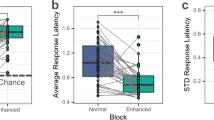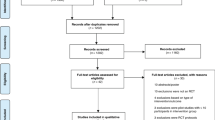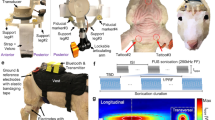Abstract
Objective:
Controlled somatosensory stimulation strategies have demonstrated merit in developing oral feeding skills in premature infants who lack a functional suck, however, the effects of orosensory entrainment stimulation on electrocortical dynamics is unknown. The objective of the study was to determine the effects of servo-controlled pneumatic orocutaneous stimulation presented during gavage feedings on the modulation of amplitude-integrated electroencephalogram (aEEG) and range electroencephalogram (rEEG) activity.
Study Design:
Two-channel EEG recordings were collected during 180 sessions that included orocutaneous stimulation and non-stimulation epochs among 22 preterm infants (mean gestational age=28.56 weeks) who were randomized to treatment and control ‘sham’ conditions. The study was initiated at around 32 weeks post-menstrual age. The raw EEG was transformed into aEEG margins, and rEEG amplitude bands measured at 1-min intervals and subjected to a mixed models statistical analysis.
Result:
Multiple significant effects were observed in the processed EEG during and immediately following 3-min periods of orocutaneous stimulation, including modulation of the upper and lower margins of the aEEG, and a reorganization of rEEG with an apparent shift from amplitude bands D and E to band C throughout the 23-min recording period that followed the first stimulus block when compared with the sham condition. Cortical asymmetry also was apparent in both EEG measures.
Conclusion:
Orocutaneous stimulation represents a salient trigeminal input, which has both short- and long-term effects in modulating electrocortical activity, and thus is hypothesized to represent a form of neural adaptation or plasticity that may benefit the preterm infant during this critical period of brain maturation.
This is a preview of subscription content, access via your institution
Access options
Subscribe to this journal
Receive 12 print issues and online access
$259.00 per year
only $21.58 per issue
Buy this article
- Purchase on Springer Link
- Instant access to full article PDF
Prices may be subject to local taxes which are calculated during checkout






Similar content being viewed by others
References
Fucile S, Gisel EG, McFarland DH, Lau C . Oral and non-oral sensorimotor interventions enhance oral feeding performance in preterm infants. Dev Med Child Neurol 2011; 53: 829–835.
Rocha AD, Moreira MEL, Pimenta HP, Ramos JRM, Lucena SL . A randomized study of the efficacy of sensory-motor-oral stimulation and non-nutritive sucking in very low birth weight infant. Early Hum Dev 2007; 83: 385–388.
Barlow SM, Finan DS, Chu S, Lee J . Patterns for the premature brain: synthetic orocutaneous stimulation entrains preterm infants with feeding difficulties to suck. J Perinatol 2008; 28: 541–548.
Barlow SM, Lee J, Wang J, Oder A, Hall S, Knox K et al. Frequency-modulated orocutaneous stimulation promotes non-nutritive suck development in preterm infants with respiratory distress syndrome or chronic lung disease, and preterm infants of diabetic mothers. J Perinatol. (acceptable pending revision).
Bingham P, Ashikaga T, Abbasi S . Prospective study of non-nutritive sucking and feeding skills in premature infants. Arch Dis Child Fetal Neonatal Ed 2010; 95: F194–F200.
Pinelli J, Symington AJ . Non-Nutritive Sucking for Promoting Physiologic Stability and Nutrition in Preterm Infants., Issue 6. The Cochrane Collaboration, John Wiley & Sons, Ltd. The Cochrane Library, 2010 pp 1–34.
Penn AA, Shatz CJ . Brain waves and brain wiring: the role of endogenous and sensory-driven neural activity in development. Pediatr Res 1999; 45: 447–458.
Griesmaier E, Enot DP, Bachmann M, Neubauer V, Hellström-Westas L, Kiechl-Kohlendorfer U et al. Systematic characterization of amplitude-integrated EEG signals for monitoring the preterm brain. Pediatr Res 2013; 73: 226–235.
Maynard DE . EEG analysis using an analogue frequency analyser and a digital computer. Electroencephalogr Clin Neurophysiol 1967; 23: 487.
Hellström-Westas L, de Vries LS, Rosén I . Atlas of Amplitude-Integrated EEGs in the Newborn 2nd edn. Informa Healthcare: UK), 2008 pp 1–187.
Hellström-Westas L, Rosén I, Svenningsen NW . Cerebral function monitoring during the first week of life in extremely small low birthweight (ESLBW) infants. Neuropediatrics 1991; 22: 27–32.
Niemarkt HJ, Andriessen P, Peters CHL, Pasman JW, Blanco CE, Zimmerman LJ et al. Quantitative analysis of amplitude-integrated electroencephalogram patterns in stable preterm infants, with normal neurological development at one year. Neonatology 2010; 97: 175–182.
Olischar M, Klebermass K, Kuhle S, Hulek M, Kohlhauser C, Rücklinger E et al. Reference values for amplitude integrated electroencephalographic activity in preterm infants younger than 30 weeks’ gestational age. Pediatrics 2004; 113: e61–e66.
O’Reilly D, Navakatikyan MA, Filip M, Greene D, Van Marter LJ . Peak-to-peak amplitude in neonatal brain monitoring of premature infants. Clin Neurophysiol 2012; 123: 2139–2153.
Zhang D, Liu Y, Hou X, Shou C, Luo Y, Ye D et al. Reference values for amplitude-integrated EEGs in infants from preterm to 3.5 months of age. Pediatrics 2011; 127: e1280–e1287.
Sisman J, Campbell DE, Brion LP . Amplitude-integrated EEG in preterm infants: maturation of background pattern and amplitude voltage with postmenstrual age and gestational age. J Perinatol 2005; 25: 391–396.
Curzi-Dascalova L, Figueroa JM, Eiselt M, Christova E, Virassamy A, d'Allest AM et al. Sleep state organization in premature infants of less than 35 weeks’ gestational age. Pediatr Res 1993; 34: 624–628.
Wikström S, Pupp IH, Rosén I, Norman E, Fellman V, Ley D et al. Early single-channel aEEG/EEG predicts outcome in very preterm infants. Acta Paediatr 2012; 101: 719–726.
Als H, Duffy FH, McAnulty G, Butler SC, Lightbody L, Kosta S et al. NIDCAP improves brain function and structure in preterm infants with severe intrauterine growth restriction. J Perinatol 2012; 32: 797–803.
Ball G, Boardman JP, Rueckert D, Aljabar P, Arichi T, Merchant N et al. The effect of preterm birth on thalamic and cortical development. Cortex 2012; 22: 1016–1024.
Kostovic I, Judas M . The development of the subplate and thalamocortical connections in the human foetal brain. Acta Paediatrica 2010; 99: e1119–e1127.
Kostovic I, Jovanov-Milosevic N . The development of cerebral connections during the first 20-45 weeks’ gestation. Semin Fetal Neonatal Med 2006; 11: 415–422.
Ball G, Boardman JP, Aljabar P, Pandit A, Arichi T, Merchant N et al. The influence of preterm birth on the developing thalamocortical connectome. Cortex 2012; 49: 1711–1721.
Fitzgerald GE, Windle WF . Some observations on early human fetal movements. J Comp Neurol 1942; 76: 159–167.
Barlow SM, Finan D, Bradford PT, Andreatta R . Transitional properties of the mechanically evoked perioral reflex from infancy through adulthood. Brain Res 1993; 623: 181–188.
Mento G, Suppiej A, Altoè G, Bisiacchi PS . Functional hemispheric asymmetries in humans: electrophysiological evidence from preterm infants. Eur J Neurosci 2010; 31: 565–574.
Dubois J, Hertz-Pannier L, Cachia A, Mangin JF, Le Bihan D, Dehaene-Lambertz G . Structural asymmetries in the infant language and sensori-motor networks. Cereb Cortex 2009; 19: 414–423.
Chi JG, Dooling EC, Gilles FH . Left-right asymmetries of the temporal speech areas of the human fetus. Arch Neurol 1977; 34: 346–348.
Dubois J, Benders M, Cachia A, Lazeyras F, Ha-Vinh Leuchter R, Sizonenko SV et al. Mapping the early cortical folding process in the preterm newborn brain. Cereb Cortex 2007; 18: 1444–1454.
Gilmore JH, Lin W, Prastawa MW, Looney CB, Vetsa YS, Knickmeyer RC et al. Regional gray matter growth, sexual dimorphism, and cerebral asymmetry in the neonatal brain. J Neurosci 2007; 27: 1255–1260.
Deoni SCL, Mercure E, Blasi A, Gasston D, Thomson A, Johnson M et al. Mapping infant brain myelination with magnetic resonance imaging. J Neurosci 2011; 31: 784–791.
Salmaso N, Silbereis J, Komitaova M, Mitchell P, Chapman K, Ment LR et al. Environmental enrichment increases the GFAP+ stem cell pool and reverses hypoxia-induced cognitive deficits in juvenile mice. J Neurosci 2012; 32 (26): 8930–8939.
Rudnicki J, Boberski M, Butrymowicz E, Niedbalski P, Ogniewski P, Niedbalski M et al. Recording of amplitude-integrated electroencephalography, oxygen saturation, pulse rate, and cerebral blood flow during massage of premature infants. Am J Perinatol 2012; 29: 561–566.
Barlow SM, Dusick A, Finan DS, Coltart S, Biswas A . Mechanically evoked perioral reflexes in premature and term human infants. Brain Res 2001; 899: 251–254.
Humphrey T . Some correlations between the appearance of human fetal reflexes and the development of the nervous system, growth, and maturation of the brain. Prog Brain Res 1964; 4: 93–135.
Toda T, Taoka M . Converging patterns of inputs from oral structures in the postcentral somatosensory cortex of conscious macaque monkeys. Exp Brain Res 2004; 58: 43–49.
Barlow SM . Mechanical frequency detection thresholds in the human face. Exp Neurol 1987; 96: 253–261.
Acknowledgements
Implementation of this program would not have been possible without extreme dedication of SCVMC NICU staff and families, Santa Clara County First Five and Valley Medical Center Foundation. This study was supported in part by grants NIH R01 DC003311 (SM Barlow), NIH P30 HD02528 and the Sutherland Family Foundation.
Author information
Authors and Affiliations
Corresponding author
Ethics declarations
Competing interests
None of the authors have a direct financial relation with the manufacturers of the Soothie pacifier, Brainz EEG monitor and Analyze software, nor with the SAS statistical software. Dr Barlow is the inventor of the NTrainer System, which is registered and licensed by the University of Kansas to Innara Health, Incorporated (Olathe, KS, USA).
Additional information
Supplementary Information accompanies the paper on the Journal of Perinatology website
Supplementary information
Rights and permissions
About this article
Cite this article
Barlow, S., Jegatheesan, P., Weiss, S. et al. Amplitude-integrated EEG and range-EEG modulation associated with pneumatic orocutaneous stimulation in preterm infants. J Perinatol 34, 213–219 (2014). https://doi.org/10.1038/jp.2013.150
Received:
Revised:
Accepted:
Published:
Issue Date:
DOI: https://doi.org/10.1038/jp.2013.150
Keywords
This article is cited by
-
Sensory-based interventions in the NICU: systematic review of effects on preterm brain development
Pediatric Research (2022)
-
Structural and functional brain asymmetries in the early phases of life: a scoping review
Brain Structure and Function (2022)
-
Frequency-modulated orocutaneous stimulation promotes non-nutritive suck development in preterm infants with respiratory distress syndrome or chronic lung disease
Journal of Perinatology (2014)



